Solution Manual for Engingeering Mechanics Dynamics in SI Units
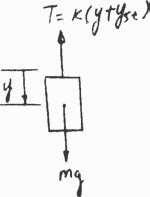
14th Edition by Hibbeler ISBN 1292088729
9781292088723
Full link download Solution Manual:
https://testbankpack.com/p/solution-manual-for-engingeering-mechanicsdynamics-in-si-units-14th-edition-by-hibbeler-isbn-12920887299781292088723/
22–1.
A spring is stretched 175 mm by an 8-kg block. If the block is displaced 100 mm downward from its equilibrium position and given a downward velocity of 1.50 m>s, determine the differential equation which describes the motion. Assume that positive displacement is downward Also,determine the position of the block when t = 0.22 s.
© Pearson Education Limited 2017.All rights reserved.This material is protected under all copyright laws as they currently exist No portion of this material may be reproduced, in any form or by any means, without permission in writing from the publisher 1193
SOLUTION $ + TΣFy = may; mg - k(y + yst) = my where kyst = mg $ k y + m y = 0 k Hence p = B m Where k = 8(9.81) 0.175 = 448.46 N>m 448.46 = B 8 = 7.487 $ $ 6 y + (7.487)2 y = 0 y + 56.1y = 0 Ans. The solution of the above differential equation is of the form: y = A sin pt + B cos pt (1) v = y = Ap cos pt - Bp sin pt (2) At t = 0, y = 0.1 m and v = v0 = 1.50 m>s From Eq. (1) 0.1 = A sin 0 + B cos 0 B = 0.1 m v0 1.50 From Eq. (2) v0 = Ap cos 0 - 0 A = p = 7.487 = 0.2003 m Hence y = 0.2003 sin 7.487t + 0.1 cos 7.487t At t = 0.22 s, y = 0.2003 sin [7.487(0.22)] + 0.1 cos [7.487(0.22)] = 0.192 m Ans.
© Pearson Education Limited 2017.All rights reserved.This material is protected under all copyright laws as they currently exist No portion of this material may be reproduced, in any form or by any means, without permission in writing from the publisher 1194 Ans: y + 56.1 y = 0 y t = 0 22 s = 0.192 m
22
2.
A spring has a stiffness of 800 N>m. If a 2-kg block is attached to the spring, pushed 50 mm above its equilibrium position, and released from rest, determine the equation that describes the block’s motion. Assume that positive displacement is downward.

SOLUTION
k p = A m = A 800 2 = 20
x = A sin pt + B cos pt
x = - 0.05 m when t = 0,
- 0.05 = 0 + B; B = - 0.05
v = Ap cos pt - Bp sin pt
v = 0 when t = 0,
0 = A(20) - 0; A = 0
Thus,
x = - 0.05 cos (20t) Ans.
2-Kg
© Pearson Education Limited 2017.All rights reserved.This material is protected under all copyright laws as they currently exist No portion of this material may be reproduced, in any form or by any means, without permission in writing from the publisher 1195
–
Ans: x =
-0.05 cos (20t)
22–3.
A spring is stretched 200 mm by a 15-kg block. If the block is displaced 100 mm downward from its equilibrium position and given a downward velocity of 0.75 m>s, determine the equation which describes the motion What is the phase angle? Assume that positive displacement is downward.
SOLUTION
© Pearson Education Limited 2017.All rights reserved.This material is protected under all copyright laws as they currently exist No portion of this material may be reproduced, in any form or by any means, without permission in writing from the publisher 1196
F k = y = 15(9.81) 0.2 = 735.75 N>m k vn = Am = A 735.75 15 = 7.00
= A sin vn t + B cos vn t y = 0.1 m when t = 0, 0.1 = 0 + B; B = 0.1 v = Avn cos vn t - Bvn sin vn t v = 0.75 m>s when t = 0, 0.75 = A(7.00) A = 0.107 y = 0.107 sin (7.00t) + 0.100 cos (7.00t) f = tan - 1 a B b = tan - 1 a 0.100 b = 43.0° Ans. Ans. A 0.107 Ans: y = 0.107 sin (7.00t) + 0.100 cos (7.00t)
y
© Pearson Education Limited 2017.All rights reserved.This material is protected under all copyright laws as they currently exist No portion of this material may be reproduced, in any form or by any means, without permission in writing from the publisher 1197
f = 43.0°
*22–4
When a 2-kg block is suspended from a spring, the spring is stretched a distance of 40 mm. Determine the frequency and the period of vibration for a 0.5-kg block attached to the same spring
© Pearson Education Limited 2017.All rights reserved.This material is protected under all copyright laws as they currently exist No portion of this material may be reproduced, in any form or by any means, without permission in writing from the publisher 1198
SOLUTION F k = y = 2(9.81) 0.040 = 490.5 N>m k vn = Am = A 490.5 0.5 = 31.321 vn f = 2p = 31.321 2p = 4.985 = 4.98 Hz Ans. 1 1 t = f = 4.985 = 0.201 s Ans. Ans: f = 4.98 Hz
© Pearson Education Limited 2017.All rights reserved.This material is protected under all copyright laws as they currently exist No portion of this material may be reproduced, in any form or by any means, without permission in writing from the publisher 1199 t = 0.201 s
22–5.
When a 3-kg block is suspended from a spring, the spring is stretched a distance of 60 mm. Determine the natural frequency and the period of vibration for a 0.2-kg block attached to the same
© Pearson Education Limited 2017.All rights reserved.This material is protected under all copyright laws as they currently exist No portion of this material may be reproduced, in any form or by any means, without permission in writing from the publisher 1200
spring SOLUTION F k = = ¢x 3(9.81) 0.060 = 490.5 N>m k vn = Am = A 490.5 0.2 = 49.52 = 49.5 rad>s Ans. vn f = 2p = 49.52 2p = 7.88 Hz 1 1 t = f = 7.88 = 0.127 s Ans. Ans: vn = 49.5 rad>s t = 0.127 s
22–6.
An 8-kg block is suspended from a spring having a stiffness k = 80 N>m. If the block is given an upward velocity of 0.4 m>s when it is 90 mm above its equilibrium position, determine the equation which describes the motion and the maximum upward displacement of the block measured from the equilibrium position. Assume that positive displacement is measured downward.
SOLUTION
k 80 vn = Am = A 8 = 3.162 rad>s
y = - 0.4 m>s, x = - 0.09 m at t = 0
x = A sin vn t + B cos vn t - 0.09 = 0 + B
B = - 0.09
y = Avn cos vn t - Bvn sin vn t - 0.4 = A(3.162) - 0 A = - 0.126
© Pearson Education Limited 2017.All rights reserved.This material is protected under all copyright laws as they currently exist No portion of this material may be reproduced, in any form or by any means, without permission in writing from the publisher 1201
x
0.09
(3.16t) m
= 2A2 + B2 = 2( - 0.126)2 + ( - 0.09) = 0.155 m Ans. Ans. Ans: x = 5 -0.126 sin (3.16t) - 0.09 cos (3.16t)6 m C = 0.155 m
Thus,
= - 0.126 sin (3.16t) -
cos
C
A pendulum has a cord of length L and is given a tangential velocity v toward the vertical from a position . Determine the equation which describes the angular motion.
SOLUTION
Since the motion remains small
© Pearson Education Limited 2017.All rights reserved.This material is protected under all copyright laws as they currently exist No portion of this material may be reproduced, in any form or by any means, without permission in writing from the publisher 1202 n n n 22–
7.
Given: L 0.4 m v 0.2 m>s 0 0.3 rad g 9.81 m>s2
g A sin t B cos t L v A B n L 0 A sin n t B cos n t A 0.101 rad B 0.30 rad n 4.95 rad >s Ans. Ans: u = A sin 1vn t2 + B cos 1vnt2 A = - 0 101 rad B = 0 30 rad vn = 4.95 rad/s
*22–8. A 2-kg block is suspended from a spring having a stiffness of 800 N m If the block is given an upward velocity of 2 m s when it is displaced downward a distance of 150 mm from its equilibrium position, determine the equation which describes the motion What is the amplitude of the motion? Assume that positive displacement is downward
SOLUTION
© Pearson Education Limited 2017.All rights reserved.This material is protected under all copyright laws as they currently exist No portion of this material may be reproduced, in any form or by any means, without permission in writing from the publisher 1203
2
0; " 0.1 Thus, Y 0.1 sin (20U) 0.150 cos (20U) $ 2"2 #2 2(0 1)2 (0.150)2 0.180 m Ans. Ans Ans: Y 0.1 sin (20U) 0.150 cos (20U) $ 0.180 m
L Q AN A 800 2 20 Y " sin QU # cos QU Y 0.150 m when U 0, 0.150 0 #; # 0.150 v "Q cos QU #Q sin QU v
m s when U 0, 2 "(20)
22–9. A 3-kg block is suspended from a spring having a stiffness of k = 200 N>m If the block is pushed 50 mm upward from its equilibrium position and then released from rest, determine the equation that describes the motion. What are the amplitude and the natural frequency of the vibration? Assume that positive displacement is downward.
SOLUTION
© Pearson Education Limited 2017.All rights reserved.This material is protected under all copyright laws as they currently exist No portion of this material may be reproduced, in any form or by any means, without permission in writing from the publisher 1204
k vn = A
= A
s Ans.
m
200 3 = 8.16 rad>
x = A sin vn t + B cos vn t
x = - 0.05 m when t = 0, - 0.05 = 0 + B; B = - 0.05 v = Ap cos vn t - Bvn sin vn t
Hence, x = - 0.05 cos (8.16t) C = 2A2 + B2 = 2(0)2 + ( - 0.05) = 0.05 m = 50 mm Ans. Ans. Ans: vn =
rad>s x =
0.05
t) C = 50 mm
v = 0 when t = 0, 0 = A(8.165) - 0; A = 0
8.16
-
cos (8.16
22–10.
The uniform rod of mass m is supported by a pin at A and a spring at B If B is given a small sideward displacement and A released,determine the natural period of vibration.
Solution
© Pearson Education Limited 2017.All rights reserved.This material is protected under all copyright laws as they currently exist No portion of this material may be reproduced, in any form or by any means, without permission in writing from the publisher 1205 a n
L
1 2 Equation of Motion. The mass
of
of
rod about A is IA = 3 mL Referring to the FBD of the rod, Fig a, B L 1 2 k a + ΣMA = IAa; - mg a 2 sin u b - (kx cos u)(L) = a 3 mL b a However; x = L sin u.Then - mgL 2 sin u - kL2 sin u cos u = 1 mL2a 3 Using the trigonometry identity sin 2u = 2 sin u cos u, - mgL 2 sin uKL2 2 sin 2u = 1 mL2a 3 Here
sin 2u 2u Also a
u
becomes 1 $ mL2u + 3 mgL 2 + kL2 b u = 0 $ 3mg + 6kL u + u = 0 2mL 3mg + 6kL Comparing to that of the Standard form, vn = A Then 2mL 2p 2mL t = v = 2pA3mg + 6kL Ans. Ans: 2mL
moment
inertia
the
since u is small sin u u and
=
Then the above equation

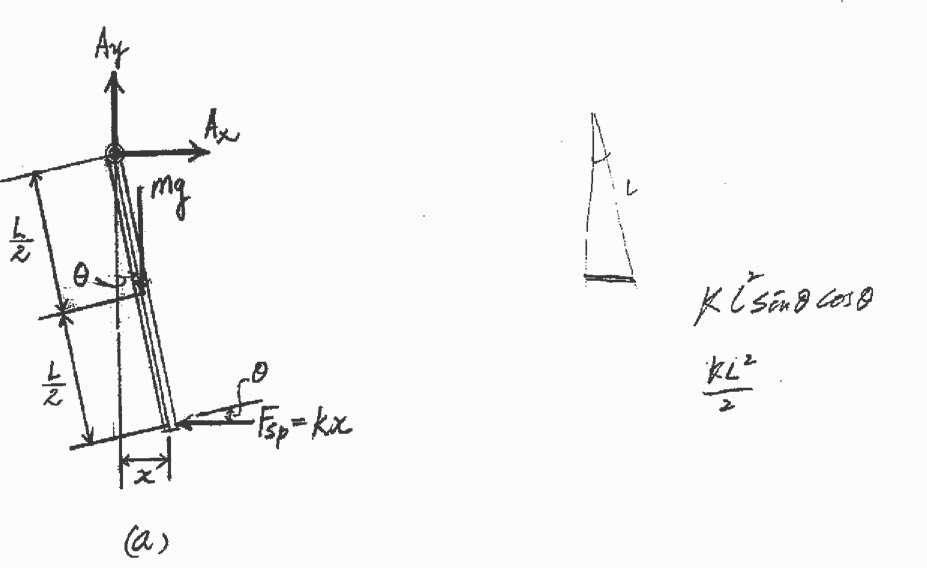
© Pearson Education Limited 2017.All rights reserved.This material is protected under all copyright laws as they currently exist No portion of this material may be reproduced, in any form or by any means, without permission in writing from the publisher 1206 t = 2pA3mg + 6kL
22–11.
The body of arbitrary shape has a mass m, mass center at G, and a radius of gyration about G of kG. If it is displaced a
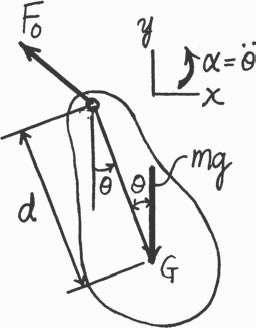

slight amount u from its equilibrium position and released,
determine the natural period of vibration.
SOLUTION
However, for small rotation sin u Lu Hence
© Pearson Education Limited 2017.All rights reserved.This material is protected under all copyright laws as they currently exist No portion of this material may be reproduced, in any form or by any means, without permission in writing from the publisher 1207 G G v k k G G
O
d
u G
a + ©MO = IO a; - mgd sin u = Cmk2 $ + md2Du $ gd u + k2 2 sin u = 0 G + d
$ gd u + k2 + d2 u = 0 gd
the
vn = B k2 2 G + d 2p t = = n 2p gd = 2pC 2 + d2 gd Ans. A 2 + d2 Ans: t = 2pC k2 + d2 G gd
From
above differentialequation,
*22–12.
The connecting rod is supported by a knife edge at A and the period of vibration is measured as tA = 3.38 s It is then removed and rotated 180° so that it is supported by the knife edge at B. In this case the perod of vibration is measured as tB = 3.96 s Determine the location d of the center of gravity G, and compute the radius of gyration kG
SOLUTION
Free-body Diagram: In general, when an object of arbitary shape having a mass m is pinned at O and is displaced by an angular displacement of u, the tangential component of its weight will create the restoring moment about point O
Equation of Motion: Sum monent about point O to eliminate O x and O y a + ©MO = IO a; - mg sin u(l) = IO a (1)
Kinematics: Since a = d2u dt2 $ = u and sin u = u if u is small, then substitute these
values into Eq. (1), we have $ - mglu = IO u $ or u + mgl IO u = 0 (2)
From Eq. (2), v 2 = mgl IO
mgl , thus, vn = B O . Applying Eq. 22–12, we have
2p IO
t = = 2pBmgl (3)
When the rod is rotating about A, t = tA = 3.38 s and l = d Substitute these values into Eq. (3),we have 3.38 = 2p IA I = 0.2894mgd mgd
When the rod is rotating about B, t = tB = 3.96 s and l = 0.25 - d. Substitute these values into Eq. (3), we have
3.96 = 2p IB I = 0.3972mg (0.25 - d) Bmg (0.25 - d) B
However, the mass moment inertia of the rod about its mass center is

IG = IA - md2 = IB - m(0.25 - d)2
Then, 0.2894mgd - md2 = 0.3972mg (0.25 - d) - m (0.25 - d)2 d = 0.1462 m = 146 mm Ans.
Thus, the mass moment inertia of the rod about its mass center is IG = IA - md2 = 0.2894m (9.81)(0.1462) - m A0.14622B = 0.3937 m
The radius of gyration is
© Pearson Education Limited 2017.All rights reserved.This material is protected under all copyright laws as they currently exist No portion of this material may be reproduced, in any form or by any means, without permission in writing from the publisher 1208 B n I v
B A n
A d G
250 mm
I
Ans: k
Ans. d = 146
kG
G 0.3937m
G = B m = A m = 0.627 m
mm
= 0.627 m
22–13.
Determine the natural period of vibration of the uniform O bar of mass m when it is displaced downward slightly and released. k
Equation of Motion The mass moment of inertia of the bar about O is I0 = 12 mL
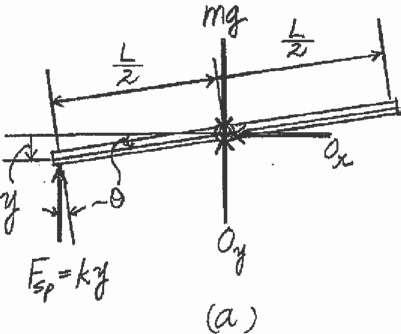

Referring to the FBD of the rod, Fig a, L 1 2 a + ΣM0 = I0a; - ky cos ua 2 b = a 12 mL b a
However, y = sin u Then 2 L L 1 2 - k a 2 sin ub cos u a 2 b = 12 mL a
Using the trigonometry identity sin 2u = 2 sin u cos u,we obtain
mL2a +
kL2 8 sin 2u = 0
Here since u is small, sin 2u 2u.Also, a = u . Then the above equation becomes
© Pearson Education Limited 2017.All rights reserved.This material is protected under all copyright laws as they currently exist No portion of this material may be reproduced, in any form or by any means, without permission in writing from the publisher 1209
n
L L 2 2
1
Solution
2
L
1
12
1
12
$ 3
m
3k
A m
2p
t = v
2pA3k Ans. Ans: m t = 2pA3k
$ 2 mL2u + kL u = 0
4
k u +
u = 0
Comparing to that of the Standard form, vn =
Then
m
=
22–14.
A platform, having an unknown mass, is supported by four springs, each having the same stiffness k. When nothing is on the platform,the period of vertical vibration is measured as 2.35 s; whereas if a 3-kg block is supported on the
platform,the period of vertical vibration is 5.23 s Determine the mass of a block placed on the (empty) platform which causes the platform to vibrate vertically with a period of 5.62 s.What is the stiffness k of each of the springs?

© Pearson Education Limited 2017.All rights reserved.This material is protected under all copyright laws as they currently exist No portion of this material may be reproduced, in any form or by any means, without permission in writing from the publisher 1210
k k
Solution + T ΣFy = may; mtg - 4k(y + yts) = mty Where 4k yts = mtg $ 4k y + mty = 0 4k Hence P = A mt 2p mt t = P = 2pA 4k For empty platform mt = mP, where mP is the mass of the platform. mP 2.35 = 2pA 4k (1) When 3-kg block is on the platform mt = mP + 3 mP + 3 5.23 = 2pA (2) 4k When an unknown mass is on the platform mt = mP + mB mP + mB Solving Eqs. (1) to (3) yields : 5.62 = 2pA (3) 4k k = 1.36 N>m mB = 3.58 kg Ans. mP = 0.7589 kg Ans: k = 1.36 N>m mB = 3.58 kg
15.
The thin hoop of mass m is supported by a knife-edge O Determine the natural period of vibration for small amplitudes of swing


© Pearson Education Limited 2017.All rights reserved.This material is protected under all copyright laws as they currently exist No portion of this material may be reproduced, in any form or by any means, without permission in writing from the publisher 1211 v 22–
r SOLUTION IO = mr2 + mr2 = 2mr2 $ c + a MO = IOa; - mgr u = (2mr 2)u $ g u + a 2r b u = 0 2p 2r t = = 2p n g Ans. Ans: 2r t = 2p A g
*22–16.
A block of mass m is suspended from two springs having a stiffness of k1 and k2, arranged a) parallel to each other, and b) as a series. Determine the equivalent stiffness of a single spring with the same oscillation characteristics and the period of oscillation for each case.
SOLUTION
(a) When the springs are arranged in parallel, the equivalent spring stiffness is
The natural frequency of the system is
Thus, the period of oscillation of the system is
(b) When the springs are arranged in a series, the equivalent stiffness of the system can be determined by equating the stretch of both spring systems subjected to the same load F
The natural frequency of the system is
Thus, the period of oscillation of the system is
2p
m(k1 + k2) k k
© Pearson Education Limited 2017.All rights reserved.This material is protected under all copyright laws as they currently exist No portion of this material may be reproduced, in any form or by any means, without permission in writing from the publisher 1212 1 k k k
k1 k2 k1
keq = k1 + k2 k2 Ans.
keq vn = C m = B k1 + k2 m (a) (b)
2p 2p
t = v = = 2pCk
k Ans. n k1 + k2 1 2 B m
m
+
F F + 1 k2 F = keq 1 1 + 1 k2 1 = keq k2 + k1 k1k2 1 = keq k1k2 keq = 1 + k2 Ans.
keq vn = C m = S k1k2 a k2 + k1 b m
t = v =
Ans. n k1k2 1 2 Ans: a k2 + k1 b S m keq = k1 + k2 m t = 2pA k + k2
2p 2p
=
C


© Pearson Education Limited 2017.All rights reserved.This material is protected under all copyright laws as they currently exist No portion of this material may be reproduced, in any form or by any means, without permission in writing from the publisher 1213 k k1k2 keq = 1 + k2 m(k1 + k2) t = 2pA k1k2
22
The 15-kg block is suspended from two springs having a different stiffness and arranged a) parallel to each other, and b) as a series If the natural periods of oscillation of the parallel system and series system are observed to be 0.5 s and 1.5 s, respectively, determine the spring stiffnesses k1 and
SOLUTION
The equivalent spring stiffness of the spring system arranged in parallel is AkeqBP = k1 + k2 and the equivalent stiffness of the spring system arranged in a series can be determined by equating the stretch of the system to a single equivalent spring when they are subjected to the same load.
Thus the natural frequenciesof the parallel and series spring system are


© Pearson Education Limited 2017.All rights reserved.This material is protected under all copyright laws as they currently exist No portion of this material may be reproduced, in any form or by any means, without permission in writing from the publisher 1214 k n P k 1
–17.
k
k1 k2 k1
2
k2
F F + 1 k2 F = (keq)S (a) (b) k2 + k1 k1k2 1 = AkeqBS k1k2 AkeqBS = 1 + k2
(vn)P = D AkeqBP m = B Akeq B S k1 + k2 15 k1k2 ¢k1 + k2 ≤ k k (vn)S = D m = U 1 2 15 = D15 k k A 1 + 2B
2p tP = (v ) = 2p B k 15 + k2 = 0.5 (1) 2p tS = (v ) = 2p D 15Ak1 + k2B k k = 1.5 (2) n S 1 2
Eqs (1) and (2), k1 = 2067 N>m or 302 N>m k2 = 302 N>m or 2067 N>m Ans. Ans.
Thus, the natural periods of oscillation are
Solving
© Pearson Education Limited 2017.All rights reserved.This material is protected under all copyright laws as they currently exist No portion of this material may be reproduced, in any form or by any means, without permission in writing from the publisher 1215 Ans: k1 = 2067 N>m k2 = 302 N>m or vice versa
22–18.
The uniform beam is supported at its ends by two springs
A and B, each having the same stiffness k When nothing is supported on the beam, it has a period of vertical vibration
of 0.83 s. If a 50-kg mass is placed at its center, the period
of vertical vibration is 1.52 s Compute the stiffness of each spring and the mass of the beam.
Eqs.
© Pearson Education Limited 2017.All rights reserved.This material is protected under all copyright laws as they currently exist No portion of this material may be reproduced, in any form or by any means, without permission in writing from the publisher 1216
A B
k k
m t = 2p A k t2 m (2p)2 = k (0.83)2 mB (2p)2 (1.52)2 (2p)2 = 2k mB + 50 = 2k (1) (2)
SOLUTION
(1) and (2)
mB = 0.03490k
B
50 = 0.1170k
B = 21.2 kg
= 609 N m Ans. Ans. Ans: mB = 21.2 kg k = 609 N>m
become
m
+
m
k
22–19.
The slender rod has a mass of 0.2 kg and is supported at O by a pin and at its end A by two springs, each having a stiffness k = 4 N>m. The period of vibration of the rod can be set by fixing the 0.5-kg collar C to the rod at an appropriate location along its length. If the springs are originally unstretched when the rod is vertical, determine the position y of the collar so that the natural period of vibration becomes t = 1 s Neglect the size of the collar.

SOLUTION

© Pearson Education Limited 2017.All rights reserved.This material is protected under all copyright laws as they currently exist No portion of this material may be reproduced, in any form or by any means, without permission in writing from the publisher 1217
y O C 600 mm k A k
Moment of inertia about O: 1 2 2 2 IO = 3 (0.2)(0.6) + 0.5y = 0.024 + 0.5y Each spring force Fs = kx = 4x. a+©MO = IO a; -2(4x)(0.6 cosu) - 0.2(9.81)(0.3 sinu) $ -0.5(9.81)(y sinu) = (0.024 + 0.5y 2) u $ -4.8x cosu - (0.5886 + 4.905y) sinu = (0.024 + 0.5y2)u However, for small displacement x = 0.6u, sin u L u and cosu = 1 Hence $ 3.4686 + 4.905y u + 0.024 + 0.5y2 u = 0 From the above differential equation, p = B 3.4686 + 4.905y 0.024 + 0.5y2 2p t = p 2p 1 = 3.4686 + 4.905y B 0.024 + 0.5y2 19.74y2 - 4.905y - 2.5211 = 0 y = 0.503 m = 503 mm Ans. Ans:
© Pearson Education Limited 2017.All rights reserved.This material is protected under all copyright laws as they currently exist No portion of this material may be reproduced, in any form or by any means, without permission in writing from the publisher 1218 y = 503 mm
*22–20.
A uniform board is supported on two wheels which rotate in opposite directions at a constant angular speed. If the x


is m, determine the frequency of vibration of the board if it A
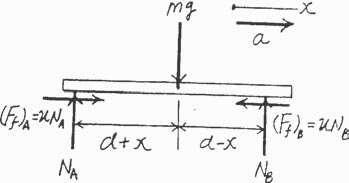

is displaced slightly,a distance x from the midpointbetween
SOLUTION
Freebody Diagram: When the board is being displaced x to the right, the restoring force is due to the unbalance friction force at A and B C(Ff)B 7 (Ff)AD
Equation of Motion:
a+©MA = ©(MA)k ; NB (2d) - mg(d + x) = 0
B = mg(d + x)
then substitute this value into Eq.(1), we have
n = . Applying Eq. 22–4, we have
© Pearson Education Limited 2017.All rights reserved.This material is protected under all copyright laws as they currently exist No portion of this material may be reproduced, in any form or by any means, without permission in writing from the publisher 1219 A
B
d d
N
2d + c©Fy = m(aG)y
mg(d
x) 2d - mg = 0 NA
mg(d - x) 2d : + ©Fx = m(aG)x ; mc mg(d-x) 2d d - mc mg mg(d + x) 2d d = ma d2x a + x = 0 d ## (1) Kinematics
a = dt2 = x,
mg x+ x = 0 d (2) 2 mg mg From
vn
v
d
vn 1 m
f = 2p = 2p d Ans. Ans:
; NA +
+
=
: Since
Eq.(2),
= ,thus,
d
g
© Pearson Education Limited 2017.All rights reserved.This material is protected under all copyright laws as they currently exist No portion of this material may be reproduced, in any form or by any means, without permission in writing from the publisher 1220 1 mg f = 2p A d
22–21.
The 50-kg block is suspended from the 10-kg pulley that has a radius of gyration about its center of mass of 125 mm. If the block is given a small vertical displacement and then released,determine the natural frequency of oscillation.

SOLUTION
Equation of Motion: When the system is in the equilibrium position, the moment equation of equilibrium written about the IC using the free-body diagram of the system shown in Fig a gives
a+©MIC = 0; AFsp B st (0.3) - 10(9.81)(0.15) - 50(9.81)(0.15) = 0
AFsp B st = 294.3 N
Thus, the initial stretch of the spring is s0 = AFsp B st k = 294.3 1500 = 0.1962 m Referring the pulley shown in Fig a, the spring stretches further sA = rA>ICu = 0.3u when the pulley rotates through a small angle u Thus, $ Fsp = k(s0 + s1) = $
1500(0.1962 + 0.3u) = 294.3 + 450u Also, aG = urG>IC = u(0.15). The mass moment of inertia of the pulley about its mass center is IG =



mkG = 10(0.125 ) = 0.15625 kg # m Referring to the free-body and kinetic
diagrams of the pulley shown in Fig b,
©MIC = ©(Mk)IC; 10(9.81)(0.15) + 50(9.81)(0.15) - (294.3 + 450u)(0.3)
$ $ $
= 10Cu(0.15)D(0.15) + 50Cu(0.15)D(0.15) + 0.15625u
$ u + 89.63u = 0
Comparing this equation to that of the standard form, the natural frequency of the system is
vn = 289.63 rad>s = 9.47 rad>s Ans.
© Pearson Education Limited 2017.All rights reserved.This material is protected under all copyright laws as they currently exist No portion of this material may be reproduced, in any form or by any means, without permission in writing from the publisher 1221
k 1500 N/m O 150 mm
2 2 2
© Pearson Education Limited 2017.All rights reserved.This material is protected under all copyright laws as they currently exist No portion of this material may be reproduced, in any form or by any means, without permission in writing from the publisher 1222 Ans: vn = 9 47 rad>s
22–22.
The bar has a length l and mass m It is supported at its ends by rollers of negligible mass If it isgiven a small displacement
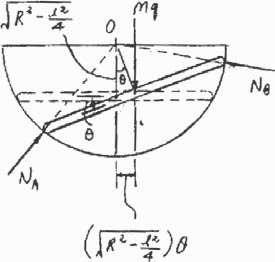
and released, determine the natural frequency of vibration.

© Pearson Education Limited 2017.All rights reserved.This material is protected under all copyright laws as they currently exist No portion of this material may be reproduced, in any form or by any means, without permission in writing from the publisher 1223 1 1
R
A B l SOLUTION Moment of inertia about point O: 1 2 2 l2 2 2 1 2 IO = 12 ml + m a B R4 b = ma R l26 l b 1 $ c + ©MO = IOa; mg a B R2 - b u = -ma R24 l2 b u 6 $ 3g(4R2 - l2)2 u + 6R2 - l2 u = 0 From the above differential equation, vn = D 3g(4R2 - l2)2 6R2 - l2 Ans. Ans:
© Pearson Education Limited 2017.All rights reserved.This material is protected under all copyright laws as they currently exist No portion of this material may be reproduced, in any form or by any means, without permission in writing from the publisher 1224 vn = C 3g(4R2 - l2)1>2 6R2 - l2
22–23.
The 20-kg disk, is pinned at its mass center O and supports the 4-kg block A. If the belt which passes over the disk is not allowed to slip at its contacting surface, determine the natural period of vibration of the system.
Solution
Equation of Motion. The mass moment of inertia of the disk about its mass

small angular displacement u, the spring stretches further by s = ru = 0.3u Thus, the total stretch is y = yst + 0.3u. Then Fsp = ky = 200(yst + 0.3u). Referring to the FBD and kinetic diagram of the system, Fig a,

a+ΣM0 = Σ(mk)0; 4(9.81)(0.3) - 200(yst + 0.3u)(0.3) = 0.90a + 4[a(0.3)](0.3)
11.772 - 60yst - 18u = 1.26a (1)
When the system is in equilibrium, u = 0° Then a+ΣM0 = 0; 4(9.81)(0.3) - 200(yst)(0.3) = 0
60yst = 11.772
Substitute this result into Eq. (1), we obtain
-18u = 1.26a
a + 14.2857u = 0
Since a = u, the above equation becomes
u + 14.2857u = 0
Comparing to that of standard form, vn = 214.2857 = 3.7796 rad>s.
Thus,
© Pearson Education Limited 2017.All rights reserved.This material is protected under all copyright laws as they currently exist No portion of this material may be reproduced, in any form or by any means, without permission in writing from the publisher 1215 n
k =3500Nm/m O A k 200 N/m 1 2 1 2 2 center O is I0 = 2 mr = 2(20)
0.3
# m . When
(
) = 0.9 kg
the disk undergoes a
2p 2p t = v = 3.7796 = 1.6623
= 1.66
Ans. Ans:
s
s
© Pearson Education Limited 2017.All rights reserved.This material is protected under all copyright laws as they currently exist No portion of this material may be reproduced, in any form or by any means, without permission in writing from the publisher 1216 t = 1.66 s
*22–24.
The 10-kg disk ispin connected at its mass center.Determine the natural period of vibration of the disk if the springs have sufficient tension in them to prevent the cord from slipping on the disk as it oscillates Hint: Assume that the initial stretch in each spring is dO
Solution
Equation of Motion. The mass moment of inertia of the disk about its mass center O
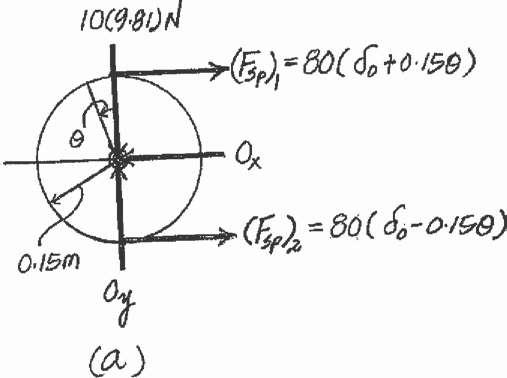
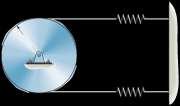
1 2 1 2 2 is I0 = 2 Mr = 2(10)(0.15 ) = 0.1125 kg # m . When the disk undergoes a small angular displacement u,the top spring stretches further but the stretch of the spring is being reduced both by s = ru = 0.15u Thus, (Fsp)t = Kxt = 80(d0 - 0.15u) and (Fsp)b = 80(d0 - 0.15u) Referring to the FBD of the disk, Fig a,
a+ΣM0 = I0a; -80(d0 + 0.15u)(0.15) + 80(d0 - 0.15u)(0.15) = 0.1125a
-3.60u = 0.1125a
a + 32u = 0
Since a = u, this equation becomes u + 32u = 0
2p = 1.1107 s = 1.11 s
t
© Pearson Education Limited 2017.All rights reserved.This material is protected under all copyright laws as they currently exist No portion of this material may be reproduced, in any form or by any means, without permission in writing from the publisher 1217 v
150 mm O k 80 N/m k 80 N/m
2p
Comparing to that of standard form, vn = 232 rad>s Then Ans. 232 Ans:
= = n
© Pearson Education Limited 2017.All rights reserved.This material is protected under all copyright laws as they currently exist No portion of this material may be reproduced, in any form or by any means, without permission in writing from the publisher 1218 t = 1.11 s
22–25.
If the disk in Prob. 22–24 has a mass of 10 kg, determinethe natural frequency of vibration. Hint: Assume that the initial stretch in each spring is dO 150 mm
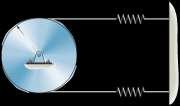
Solution
Equation of Motion. The mass moment of inertia of the disk about its mass center O 1 2 1 2 2 is I0 = 2 mr = 2(10)(0.15 ) = 0.1125 kg # m when the disk undergoes a small

angular displacement u, the top spring stretches but the bottom spring compresses, both by s = ru = 0.15u Thus, (Fsp)t = (Fsp)b = ks = 80(0.15u) = 12u Referring to the FBD of the disk, Fig a,
a+ΣM0 = I0a; -12u(0.3) = 0.1125a
-3.60u = 0.1125a
a + 32u = 0
Since a = u, this equation becomes u + 32u = 0
Comparing to that of Standard form, vn = 232 rad>s Then
vn f = 2p = 232 2p = 0.9003 Hz = 0.900 Hz
© Pearson Education Limited 2017.All rights reserved.This material is protected under all copyright laws as they currently exist No portion of this material may be reproduced, in any form or by any means, without permission in writing from the publisher 1219
O k
N
m k 80 N/m
80
/
Ans:
© Pearson Education Limited 2017.All rights reserved.This material is protected under all copyright laws as they currently exist No portion of this material may be reproduced, in any form or by any means, without permission in writing from the publisher 1220 f = 0.900 Hz
22–26.
A flywheel of mass m, which has a radius of gyration about its center of mass of kO, is suspended from a circular shaft that has a torsional resistance of M = Cu If the flywheel is given a small angular displacement of determine the natural period of oscillation. u and released,
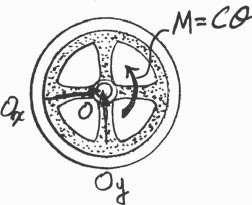
Equation of Motion: The mass moment of inertia of the wheel about point O is IO = mkO 2 Referring to Fig a, $ u a + ©MO = IO a; - Cu = mkO 2u

C u + mkO 2 u = 0
Comparing this equation to the standard equation,the natural circular frequency of the wheel is


Thus, the natural period of the oscillation is
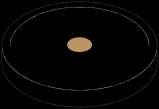
© Pearson Education Limited 2017.All rights reserved.This material is protected under all copyright laws as they currently exist No portion of this material may be reproduced, in any form or by any means, without permission in writing from the publisher 1221 O k m n
L
O
SOLUTION
$
C vn = A mk 1 C 2 = AO
2p m t = v = 2pkOA C Ans. Ans: m t = 2pkO A C
22–27.
If a block D of negligible size and of mass m is attached at C, and the bell crank of mass M is given a small angular displacement of u, the natural period of oscillation is t1 When D is removed, the natural period of oscillation is t2
Determine the bell crank’s radius of gyration about its center of mass, pin B, and the spring’s stiffness k The spring is unstrectched at u = 0°, and the motion occurs in the horizontal plane.
SOLUTION
Equation of Motion: When the bell crank rotates through a small angle u, the spring stretches s = au Thus, the force in the spring is Fsp = ks = k(au) The mass moment of inertia of the bell crank about its mass center B is IB = MkB 2 Referring to the free-body diagram of the bell crank shown in Fig a,


c + ©M = I a; - k(au) cos u(a) = Mk 2$ B B B uB


$ ka2 u + (cos u)u = 0 (1) MkB 2
Since u is very small, cos u 1 Then Eq.(1) becomes $ ka2 u + u = 0 MkB 2 $
Since the bell crank rotates about point B, aC = arBC = u(a) Referring to the freebody diagram shown in Fig b,
c + ©M = ©(M ) ; - k(au) cos u(a) = Mk 2$ + mC $ (a)D(a) B k B B u u
$ ka2 u + (cos u)u = 0 (2) MkB 2 + ma2
Again, cos u 1,since u is very small. Thus, Eq. (2) becomes
$ ka2 u + u = 0 MkB 2 + ma2
© Pearson Education Limited 2017.All rights reserved.This material is protected under all copyright laws as they currently exist No portion of this material may be reproduced, in any form or by any means, without permission in writing from the publisher 1222
a
A a u D C
k B
Thus, the natural frequenciesof the two oscillations are
© Pearson Education Limited 2017.All rights reserved.This material is protected under all copyright laws as they currently exist No portion of this material may be reproduced, in any form or by any means, without permission in writing from the publisher 1223 B B n 2 n 1 t m
22–27. continued
ka2 (vn)2 = B Mk 2 ka2 (vn)1 = B Mk 2 + ma 2
are 2p t2 = (v ) 2p t1 = (v ) = 2pB = 2pB MkB 2 ka2 MkB 2 + ma2 ka2 Solving, m t2 2 kB = a DM ¢t 2 - t 2 ≤ 1 2 4p2 k = m t1 2 - t2 2 Ans Ans Ans: 2 2 kB = aCM a t2 2 b 4p2 k = t2 1 - t2 2 m 1 - t2
The natural periods of the two oscillations
*22–28.
The platform AB when empty has a mass of 400 kg, center If a car, having a mass of 1.2 Mg and center of mass at G2,is placed on the platform, the natural period of oscillation becomes t2 = 3.16 s Determine the moment of inertia of the car about an axis passing through G2

SOLUTION
Free-body Diagram: When an object arbitrary shape having a mass m is pinned at O and being displaced by an angular displacement of u,the tangential component of its weight will create the restoring moment about point O
Equation of Motion: Sum moment about point O to eliminate Ox and Oy.
a+©MO = IOa : -mg sin u(l) = IOa (1)
Kinematics: Since a = d2u dt2 $ = u and sin u = u if u is small, then substituting these values into Eq. (1), we have $ -mglu = IOu $ or u + mgl IO u = 0
From Eq. (2), v2 = 2p
mgl IO
mgl , thus, vn = B O IO
,Applying Eq. 22–12,we have
t = v = 2pB mgl (3)
n
When the platform is empty, t = t1 = 2.38 s, m = 400 kg and l = 2.50 m
Substituting these values into Eq. (3), we have (IO)p
2.38 = 2p (I ) = 1407.55 kg # m
C400(9.81)(2.50) O p
When the car is on the platform,t = t2 = 3.16 s, m = 400 kg + 1200 kg = 1600 kg. 2.50(400) + 1.83(1200) l = 1600 = 1.9975 m and IO = (IO)C + (I

1407.55 Substituting these values into Eq (3), we have (IO)C + 1407.55 2 3.16 = 2pD1600(9.81)(1.9975)(IO)C = 6522.76 kg # m
+
Thus, the mass moment inertia of the car about its mass center is (IG)C = (IO)C - mCd2 = 6522.76 - 1200(1.832) = 2.50(103) kg # m2 Ans.
© Pearson Education Limited 2017.All rights reserved.This material is protected under all copyright laws as they currently exist No portion of this material may be reproduced, in any form or by any means, without permission in writing from the publisher 1224 n I
1.83 m G2 G1 2.50 m A B
(2)
2
O)p = (IO)C
© Pearson Education Limited 2017.All rights reserved.This material is protected under all copyright laws as they currently exist No portion of this material may be reproduced, in any form or by any means, without permission in writing from the publisher 1225 Ans: (IG)C = 2.50(103) kg # m2
22–29.
The plate of mass m is supported by three symmetrically placed cords of length l as shown. If the plate is given a slight rotation about a vertical axis through its center and released,determine the natural period of oscillation.
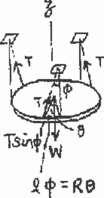

© Pearson Education Limited 2017.All rights reserved.This material is protected under all copyright laws as they currently exist No portion of this material may be reproduced, in any form or by any means, without permission in writing from the publisher 1226 n
l Solution 1 2 $ l 120 l ΣMz = Iza - 3(T sin f)R = 2 mR u sin f K f R 120 120 $ 6T u + Rm f = 0 ΣFz = 0 3T cos f - mg = 0 f = 0, T = mg R , f = u 3 l $ 6 mg R u + Rm a 3 b a l u b = 0 $ 2g u + l u = 0 2p l t = v = 2pA2g Ans. Ans: l t = 2pA2g
22–30.
Determinethe differentialequation of motion of the 3-kg block when it isdisplaced slightly and released The surface issmooth and the springs are originally unstretched.

SOLUTION
T + V = const.
T = 1 (3) 2x 2 1 1
V = (500)x 2 + (500)x 2 2 2
T + V = 1.5 2 + 500x 2 x
1.5(2 # ) $ + 1000 # = 0 x x xx
3$ + 1000x = 0 x
$ x + 333x = 0
© Pearson Education Limited 2017.All rights reserved.This material is protected under all copyright laws as they currently exist No portion of this material may be reproduced, in any form or by any means, without permission in writing from the publisher 1227
k 500 N/m 3 kg k 500 N/m
Ans: x + 333x = 0
Ans.










































